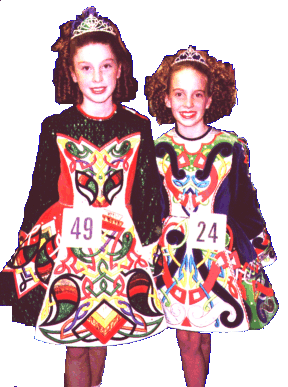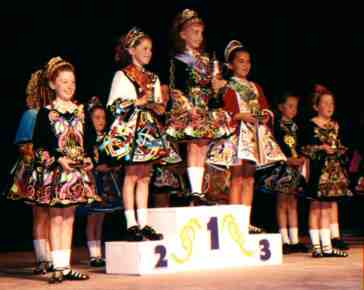Getting out of Beginners
After your child has competed in Beginners for some time, she will also start to learn in class, dances which are not considered Beginners steps. She will then be in a position to compete at the next levels... Primary, Elementary and Intermediate.
Your child can still dance in Beginners, however she must dance ‘beginners dances’. If she dances harder steps in the lower grade she will not be marked at all, as this would not be fair to the real beginners. So at some competitions you may be ticking six or seven dances on the entry form. Be aware that this can tire a small child. However, sometimes in the case of children with a dancing background in some other area, she may take to Irish very quickly and start to come First Place in Beginners. If this happens and there are over seven children in the contest, she will be promoted to Primary and no longer be allowed to compete in the Beginner grade in that dance.
Primary
At the Primary level your child will learn harder dances.
Steps she learns in Primary cannot be used in Beginners.
Steps such as twists will be included.
Elementary
A new grade introduced is called Elementary. Elementary
has the same steps as Intermediate and Open. These steps
must not be danced in lower grades. The idea of
Elementary is to bridge the gap between Primary and
Intermediate and allows those newly upgraded from Primary
a chance to adjust to the harder steps required of them.
If you win in Elementary with eight or more dancers
competing you must now dance in Intermediate in that
dance.
Intermediate
You can stay at this level until you win a section
against eight or more dancers and then you will be
promoted to Open. The steps are the same for Elementary
Intermediate and Open.
Open
This is the highest level at which a dancer can dance.
PremiershipsWhen your child learns more difficult dances she can enter the Premiership section of the competitions. In this section the competitor dances, say, a reel and a jig and the points are added together. Premierships are danced in age divisions e.g. 8yr old Premiership. Trophies are awarded to the best overall dancers. Sometimes there are Reserve Premierships which can only be entered by dancers who have not previously won a major trophy.The scoring of Championships is a little different to those at Beginners Competitions. Once you have been to a few you might like to find out how the scoring is calculated. |
 |
State and National Competitions
The State Championships are held over a full weekend in August each year. The Australians are held by each capital city in turn and competition goes over a week in the October school holidays. Each dancer is judged on her overall performance in two dances and if she does well she will be recalled to dance her Set Dance. Her mark will be an aggregate of all three dances. Which three dances she dances depends on her age: These are listed in a table belowAt the top of a dancers career are the World Championships. Mostly they are held in Ireland. 2002 will see them held outside of Ireland for the first time. They will be in Glasgow. Read about the history of the World Championships Girls' and Ladies' Grades |
Sub Minors |
Reel /Jig /Trad Set Dance |
Minors 9yr |
Reel/Hornpipie/Jig time Set Dance |
Minors 10 yr |
Slip Jig/Hornpipe/HP time Set Dance |
Junior Girls 11 |
Reel/Jig/Set Dance |
Junior Girls 12 |
Slip Jig/Hornpipe/Set Dance |
Int Girls 13 |
Reel/Jig /Set Dance |
Int Girls 14 |
Slip Jig/Hornpipe/Set Dance |
Senior Girls 15 |
Reel/Jig /Set Dance |
Senior Girls 16 |
Slip Jig/Hornpipe/Set Dance |
Junior Ladies 17 |
Reel/Jig/Set Dance |
Junior Ladies 18 |
Slip Jig/Hornpipe/Set Dance |
Ladies 19 & 20 |
Slip Jig/Hornpipe/Set Dance |
Senior Ladies 21+ |
Slip Jig/Jig/Set Dance |
Boys' and Men's Grades
Sub Minor Boys |
Reel /Jig /Trad Set Dance |
Minor Boys |
Hornpipe/Reel/ Jig time Set Dance |
Junior Boys |
Jig/Reel/Set Dance |
Int. Boys |
Hornpipe / Reel / Set Dance |
Senior Boys |
Jig/Reel/Set Dance |
Junior Men |
Hornpipe / Reel /Set Dance |
Men |
Jig / Reel /Set Dance |
Senior Men |
Jig / Reel / Set Dance |
Set Dances
Set Dances are chosen by the teacher for the dancer. They are either in Jig time or Hornpipe time. In Australia you can pick whichever one suits the child, however in international competition you have to dance opposite time to the hard shoe dance. (if your hardshoe is a jig then your set must be a hornpipe time set)
They are longer than the hardshoe dance and some of them are quite long and they are usually only done by stronger,older dancers. Planxty Davis and Kilkenny Races are long. They can be made ever longer still by the speed of the music. In competition the speed is announced to the musician and he will adjust his metronome to suit. A dance at 76 beats per minute goes on a lot longer than the same dance at 101 beats per minute.
| Hornpipe Time - Set Dances | Jig Time - Set Dances |
| The Ace & Deuce of
Pipering The Blackbird (trad) Bonaparte's Retreat The Downfall of Paris Garden of Daisies (trad) The Hunt Job of Journey Work Kilkenny Races King of the Fairies Lodge Road Madame Bonaparte Piper through the Meadow Straying Planxty Davis Planxty Drury Youghal Harbour The Blue Eyed Rascal new The Four Masters new The Roving Pedlar new |
The Blackthorn Stick The Drunken Gauger The Funny Tailor The Humours of Bandon Hurry the Jug Jockey to the Fair Miss Brown's Fancy The Orange Rogue Rub the Bag St Patrick's Day (trad) Three Sea Captains The Deep Green Pool new The Fiddler round the Fairy Treenew The Sprig of Shellelah new The Storyteller new The Wandering Musician new |
